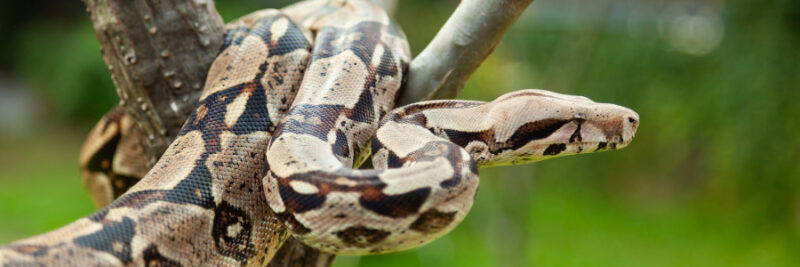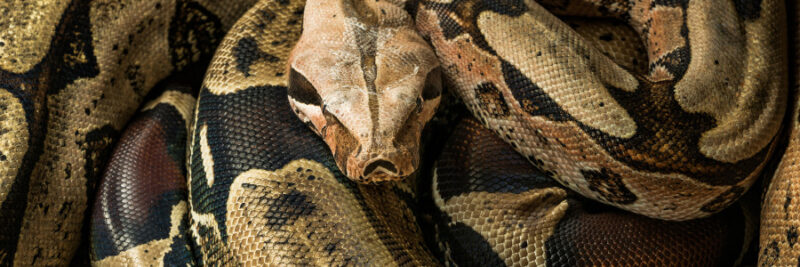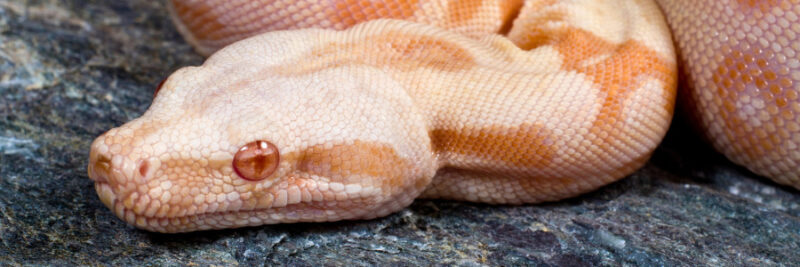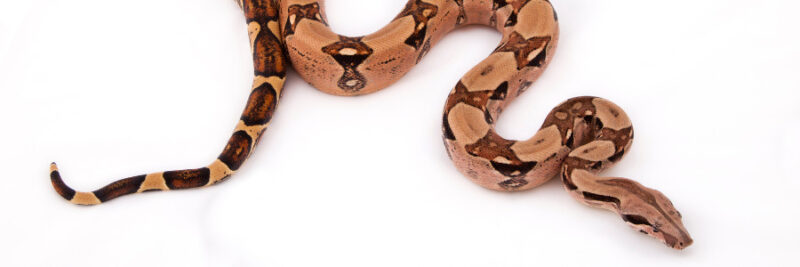So you’re thinking about getting a boa constrictor as your first pet snake? That’s awesome! As someone just starting out though, I’m sure you have a ton of questions about what it takes to properly care for one of these incredible reptiles. Well let me tell you, boa constrictors make for a very manageable and rewarding snake for beginner owners who put in the initial effort to understand their needs.
Now I’ll be real with you, while boas are totally manageable pets, they do get quite large, live a long time, and require a substantial commitment on your part to house them adequately and keep them healthy throughout their 20+ year lifespan! But when cared for properly, boas tend to have pleasant personalities, tolerate regular handling, and make for captivating display pets.
In this complete beginner’s guide, I’ll simplify everything you need to know to successfully care for a boa constrictor, including ideal enclosure size, heating and humidity guidance, handling techniques, proper feeding, what to expect with boas, and even debunk some myths about their temperament. My goal is to fully prep you for boa ownership, so let’s dive in!
Enclosure Size - Providing Ample Room

The very first thing any prospective boa owner must consider is having an adequately sized enclosure ready. A common beginner mistake is underestimating just how large these snakes become. While young hatchlings start out tiny at just 12-18 inches, boa constrictors grow rapidly. Within the first year alone, expect your boa to reach 3-4 feet long if cared for properly.
Adult female boas typically reach 6-8 feet long when mature, while males max out slightly smaller in the 5-7 foot range. Now before the size scares you off, this is precisely why it’s crucial to start boas in a large enough enclosure that allows room for growth, saving you the hassle of repeatedly upgrading tanks.
So what’s the minimum recommended enclosure dimensions?
For adult boas 7 feet and under, aim for a tank size no smaller than 4 ft long x 2 ft wide x 2 ft tall. This allows enough horizontal space for extending their body and climbing opportunities with branches. Make sure the enclosure is escape proof as well given their prowess at squeezing through small gaps and lifting lids!
Now once your boa exceeds 7 feet in length, it’s time to upgrade to a larger commercial reptile enclosure or custom built cage approximately 8 feet long x 3 feet wide x 2 feet tall.
I always recommend boa owners invest upfront in the adult size enclosure from the start. Not only does this save you upgrading hassles, but raising a boa in a spacious environment reduces stress that can otherwise trigger aggressive feeding responses in juveniles down the line.
Heating & Humidity - Getting It Right

Along with housing size, arguably the most important aspects of boa constrictor care involve dialing in the right temperature range and humidity levels. Providing proper heat and hydration supports optimal digestion and shedding cycles.
Boas hail from tropical Central and South American rainforests, so they thrive at relatively high humidity along with a temperature gradient allowing self-regulation. What does this mean exactly for your at-home boa habitat?
Heating
On the cool end of the tank, maintain ambient temperatures of 75-80°F. On the warm end where you concentrate heat sources, aim for 85-88°F surface temps. You’ll also want an isolated hot spot topping out around 90-92° allowing your boa to properly thermoregulate.
The most natural way to establish this temperature gradient includes placing a heat pad or under tank heating mat (UTH) under one end of the tank. This creates beneficial “belly heat” as your boa coils over the warm zone. Use an overhead ceramic heat emitter or radiant heat panel during colder months to boost air temps.
Humidity
Boa constrictors hail from humid tropical environments making moisture vital for healthy shedding cycles. Use a hygrometer to monitor humidity levels, which should range from 60-75%.
You can bump levels through several techniques: mist the enclosure daily, provide a humid hide box, use cypress mulch substrate which holds moisture well, and restrict ventilation to retain natural humidity from a large water bowl. Just be wary of stagnant conditions that promote scale rot in persistently wet bedding.
Feeding Your Boa Constrictor
Another beginner area that often causes anxiety involves properly feeding your boa constrictor. Luckily, boas are eager yet patient eaters when housed at appropriate temperatures. Hatchlings under a year may strike at movement in their cage out of hunger when very young. But with regular feedings boas soon transition to gentler mannerisms unless they smell food cues.
How Often To Feed
Baby boa constrictors under a year should eat weekly. Offer appropriately sized feeder prey about as thick as the widest point of the snake’s body. At one year old up to adulthood, graduat to every 2 weeks. Adults eat medium rats sized equal to the boa’s width every 4-6 weeks.
Varied Diet
For healthy growth and lifespans, offer prey variety including rats, mice, chicks and rabbits. Don’t handle your boa after touching rodents to avoid triggering mistaken bites. Use long feeding tongs instead of fingers when feeding.
Regurgitation Precautions
Avoid moving or handling your boa for at least 48 hours after eating to allow proper digestion and prevent regurgitation. Also don’t feed when preparing for a shed cycle, indicated by opaque eyes.
Handling Your Boa & Understanding Behaviors

Alright, this brings us to the question all prospective boa owners have – what about handling? Are boa constrictors aggressive snakes? Can I safely handle one as a beginner?
Let’s dispel some myths right now. Boas tend to be quite docile snakes that tolerate regular handling extremely well when cared for properly. In fact, daily handling when possible is beneficial to keep these snakes calm for maintenance and cage cleaning.
Starting Young
The key for a handleable, people-friendly boa over its 20+ year lifespan involves getting specimens young and handling frequently. But don’t overdo it at first! Allow at least a week minimum for adjustment to a new enclosure before initial handling attempts.
Nippy Neonates
As neonates and juveniles under about 3 feet long, nearly all boas go through a “nippy” defensive stage between 6 months and 1 year old. They may hiss and strike anything wandering into their territory during this period. But don’t let this temporary behavior scare you off!
With ample cage heating/humidity and regular, gentle handling sessions, even nippy baby boas soon transition to extremely docile behavior by 18 months old. Always support their entire body to restrict biting opportunities during this stage.
Expect some initial squirminess and mock “strikes” without contact at first. But calm persistence pays off allowing them to differentiate cage intruders from welcomed handlers.
What To Expect From Your Boa Over Time

Boas shed often as juveniles while going through rapid growth spurts. This decreases to about 4 times annually at adulthood.
Don’t be startled if your boa goes off food for months during winter brumation periods. This is natural seasonal fasting behavior similar to hibernation.
Monitor increasing girth to catch potential obese weight gain which stresses boas. An overly fat looking midsection likely means cutting back prey size and feeding frequency.
Well there you have it! The complete beginner’s overview on successfully caring for boa constrictors. By following this boa husbandry and handling advice, you’ll avoid many common pitfalls owners encounter. Before you know it, you’ll have a gorgeous, people-friendly boa that brings years of enjoyment as a lifelong pet reptile!
Still have some lingering questions? Here’s a quick FAQ covering additional key beginner topics for getting started.
Frequently Asked Questions for Boa Constrictors
While their proper care is very manageable overall, the main consideration is the large commitment owning a boa entails regarding enclosure size and their 20+ year lifespan. But by following the husbandry advice covered and getting a baby boa for handling, they make fantastic starter snakes.
The Central American boa along with Colombian red-tail boa are most recommended. Their max lengths stay a bit more manageable compared to larger South American localities. But all boa subspecies follow the same general care when captive bred.
Handle for just 5 minutes every few days when new to reduce stress. At about one month once settled in, handle gently but consistently for 10-15 minutes daily. Frequent handling ensures a docile personality long-term.
Don't feel discouraged by a nippy, hissy juvenile! This defensive behavior is temporary before they realize proper handlers bring no harm. Ensure cage heat and humidity meet proper levels. Give them adjustment time without reaching in before handling attempts. Hissing means a stressed boa feeling threatened.
Owning a boa constrictor is a big commitment, but following the enclosure, heating, humidity, feeding, and handling advice covered here sets both you and your boa up for success. Providing for their basic needs while regularly interacting with your boa from a young age leads to a friendly, thriving snake that brings enjoyment for years to come. Boa constrictors have quite simple care requirements overall, making them a very manageable beginner pet reptile if you ensure adequate housing size as they grow. By starting with the proper setup and techniques outlined, even first-time owners can keep their boa both healthy and handleable for their full 20+ year lifespan.
